Fallout stocks: Pepsi v Coca-Cola; plus, I got $500,000 in ETFs – is that good?
On The Australian Investors Podcast, Owen Rask & Drew Meredith, CFP answer your investing questions about ASX shares, ETFs and more.
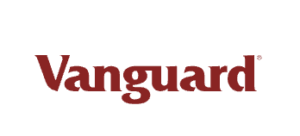
Vanguard Australian Shares Index ETF (ASX: VAS) provides exposure to the largest 300 Australian shares, based on market capitalisation. This is a low-cost way to access top Australian companies through a single fund.
The Vanguard Australian Shares Index ETF (ASX: VAS) is Australia’s largest ETF — and by a very long way. With $11 billion of investments in the VAS ETF as of July 2022, the next closest index fund ETF is iShares S&P 500 ETF (ASX: IVV) with $5 billion. That’s a huge difference considering there are over 200 ETFs in Australia.
The Vanguard Australian Shares ETF is simple but unique — it buys and holds the top 300 shares on the Australian stock exchange, ranked by size/market capitalisation. VAS tracks the S&P/ASX 300 index, making it relatively unique amongst its peers.
Vanguard is the issuer of the VAS ETF and has decades of experience providing similar types of ETFs and index funds. Other big ETFs provided by Vanguard include Vanguard MSCI International Shares ETF (ASX: VGS) and Vanguard Total US Market Shares ETF (ASX: VTS).
The key alternative Australian shares ETFs to VAS are as follows:
The VAS ETF can be used by investors to get exposure to Australian shares/equities, with a tiny cost per year (0.1%). Basically, buying VAS is like ‘owning the market’ for next to nothing. This is one reason why VAS has proven to be so popular.
Given VAS’ unique focus on the top 300 Australian shares, as opposed to the top 200 followed by most competing ETFs, VAS captures some exposure to the small and medium-sized companies on the ASX. That is, the companies ranked between 200 and 300 in size.
With low costs, diversification, dividend income and franking credits, it’s easy to see why VAS is the most popular ‘Core’ ETF in Australia.
It should be noted that if you own similar ETFs, such as A200, STW, IOZ or MVW, you’re going to have a lot of ‘overlap’ in your portfolio if you own more than one of these ETFs.
If you’re comparing VAS to other index fund shares ETFs, its risk level should be relatively the same.
However, compared to bond ETFs, VAS will be riskier (volatile).
Compared to sector-specific ETFs or thematic ETFs (e.g. ACDC, CLNE. HACK, etc.) VAS should be slightly less risky over a full market cycle given it’s diversified across sectors and company types.
Given it is an Australian shares ETF, investors should consider VAS as part of the ‘risk on’ side of a portfolio and seek to hold the ETF for a minimum of 7 years to ensure the portfolio is given time to produce results in most market environments.
Yes. VAS will pay or ‘pass through’ the franking credits it receives from its holdings. If you’re especially focused on fully franked dividend income you might try something like the VHY ETF (also from Vanguard) as either a complement or replacement to VAS.
***
Cheers!
Owen Raszkiewicz
Founder of Best ETFs Australia, lead analyst of Rask Core
On The Australian Investors Podcast, Owen Rask & Drew Meredith, CFP answer your investing questions about ASX shares, ETFs and more.
The Wesfarmers (ASX: WES) share price is one the ASX’s best performers. But are WES shares better than Vanguard Australian Shares ETF (ASX:VAS)?
For 20 years Commonwealth Bank of Australia (ASX: CBA), BHP Group (ASX: BHP) have provided great income. But they’re no longer the best way to invest for passive income.
Owen Rask, Chief Investment Officer of Rask Invest, and Mitchell Sneddon, Head of Funds Management for The Rask Group answer your questions about building passive income for retirements, using ETFs.
There are many reasons Owen Rask sees ETFs and the stock market playing a bigger role in his own portfolio. This article shows us how to build a reliable retirement portfolio.
Land tax, vacancy tax, passive income, Super top-ups… you name it. It’s covered on this weekend’s Australian Investors Podcast.
Owen Rask is the Chief Investment Officer of Rask Invest, and tells you exactly how and why he is investing for the next 10 years.
In this 2 Sense episode of The Australian Investors Podcast, Rask’s Chief Investment Officer Owen Rask and Wattle Partners Managing Director Drew Meredith, CFP answer your questions and get to the bottom this week’s Reserve Bank of Australia interest rate rise.
Will Ozempic sink ResMed Inc (ASX:RMD) and CSL Limited (ASX:CSL)? Will Tesla’s Cyber Truck come to Australia? The Australian Investors Podcast explains…
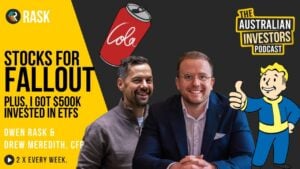
On The Australian Investors Podcast, Owen Rask & Drew Meredith, CFP answer your investing questions about ASX shares, ETFs and more.

The Wesfarmers (ASX: WES) share price is one the ASX’s best performers. But are WES shares better than Vanguard Australian Shares ETF (ASX:VAS)?
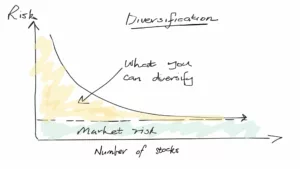
For 20 years Commonwealth Bank of Australia (ASX: CBA), BHP Group (ASX: BHP) have provided great income. But they’re no longer the best way to invest for passive income.
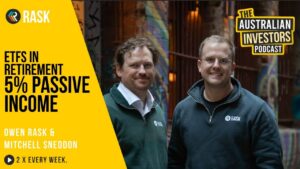
Owen Rask, Chief Investment Officer of Rask Invest, and Mitchell Sneddon, Head of Funds Management for The Rask Group answer your questions about building passive income for retirements, using ETFs.
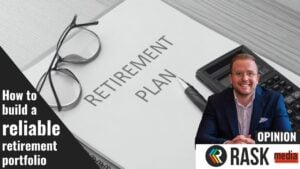
There are many reasons Owen Rask sees ETFs and the stock market playing a bigger role in his own portfolio. This article shows us how to build a reliable retirement portfolio.
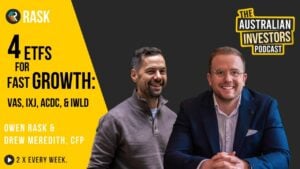
Land tax, vacancy tax, passive income, Super top-ups… you name it. It’s covered on this weekend’s Australian Investors Podcast.

Owen Rask is the Chief Investment Officer of Rask Invest, and tells you exactly how and why he is investing for the next 10 years.
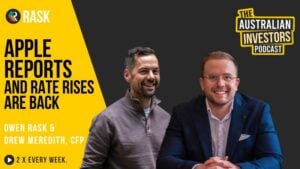
In this 2 Sense episode of The Australian Investors Podcast, Rask’s Chief Investment Officer Owen Rask and Wattle Partners Managing Director Drew Meredith, CFP answer your questions and get to the bottom this week’s Reserve Bank of Australia interest rate rise.
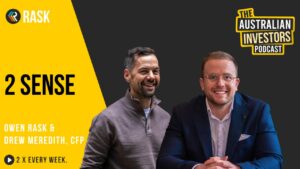
Will Ozempic sink ResMed Inc (ASX:RMD) and CSL Limited (ASX:CSL)? Will Tesla’s Cyber Truck come to Australia? The Australian Investors Podcast explains…